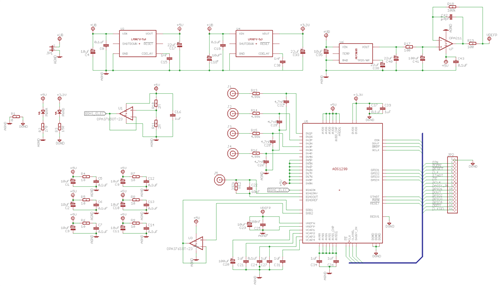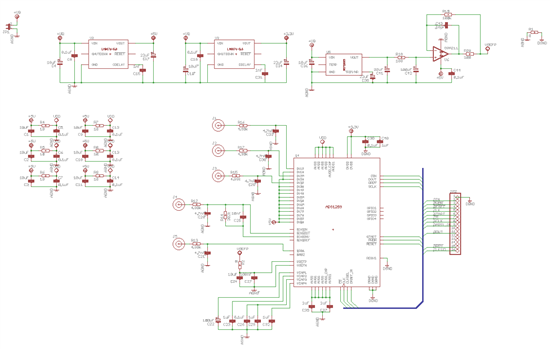Hi everyone!
I'm currently working on a schematic for a basic eeg-application (brain-computer interface) with an ADS1299, see picture below. I have two unipolar supplies (+5V analog, +3.3V digital, LM9076). I'm using a REF5025 2.5V Voltage Reference for the ADC. I have 4 Ag/AgCl electrodes (just simple ones, no shielding) and I want to use two of them as signal electrodes. One electrode should act as a reference (routed to negative input pins via SRB1) and I would like to use the Bias Drive. I have read the Documentation for the ADS1299 Demo kit and also the appnote sbaa188.pdf about improving CMR. But I still haven't figured out how to deal with the Bias Drive in my setup.
As I have seen on page 59 of the ADS1299 datasheet, I need seperate BIASOUT and BIASIN electrodes (that means, I would would need a fifth electrode). A basic question about the Bias Drive: When I use the internal mid-supply option (that is 2.5V), the BIASIN senses the current common mode voltage and via the BIASOUT electrode the ADS1299 will drive the body until the common mode voltage reaches BIASREF? Why do I need other electrodes for Bias sensing then? Like it's stated in the first two codelines for the Bias drive on page 5:
WREG BIAS_SENSP 07h // Select channel 1—3 P-side for bias sensing
WREG BIAS_SENSN 07h // Select channel 1—3 N-side for bias sensing
How are the electrodes (especially the BIASOUT electrode) connected to the body? Just a 5k protection resistor or with additional capacitors like in the schematic below? By the way, on the schematic there's still the BIAS_ELEC connected to BIASIN, I would leave that input open and select one of the above electrodes via the input mux as bias electrode of course.
If a low-frequency common mode voltage is coupled into the body, the feedback loop will take care about it, right? So when the common mode voltage is set properly, the every ADC will measure 0V (in the best case of course)?
What do you think about an additional highpass at every input? I would set the cut-off frequency at around 1Hz to get rid of DC-part and very slow brain waves. I'm interested in sensomotoric waves, e.g. thinking of a arm or leg movement.
Maybe I don't need a bias drive? I'm not sure if I get another electrode, so I could go with the option of two differential amplifiers then. But I would need a bipolar supply for the differential version, right?
I hope you guys can help me, I'm really stuck here right now.
greetings,
Andreas



